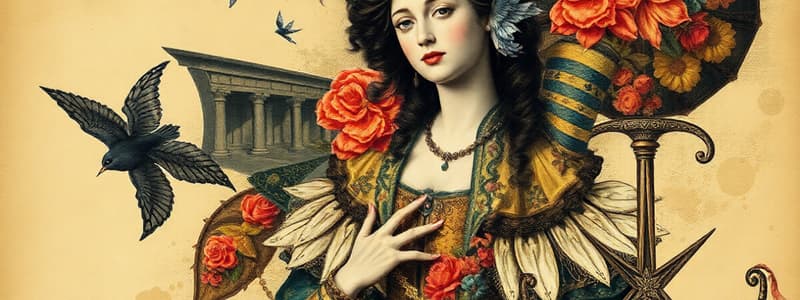Podcast
Questions and Answers
What virtue does the Redcross Knight represent in Book I?
What virtue does the Redcross Knight represent in Book I?
- Integrity
- Wisdom
- Holiness (correct)
- Courage
Who is the main antagonist that Redcross Knight faces in Book I?
Who is the main antagonist that Redcross Knight faces in Book I?
- The monster Error
- The dragon (correct)
- Evil wizard Archimago
- The sorceress Duessa
What does Redcross Knight's shield depict?
What does Redcross Knight's shield depict?
- A white dove
- A red Christian cross (correct)
- A green cross
- A golden lion
In Book II, which virtue does Sir Guyon represent?
In Book II, which virtue does Sir Guyon represent?
Which character disguises himself to lead Redcross Knight astray?
Which character disguises himself to lead Redcross Knight astray?
What ultimately saves Redcross Knight from despair?
What ultimately saves Redcross Knight from despair?
What does Guyon encounter after meeting the dying Amavia?
What does Guyon encounter after meeting the dying Amavia?
How long does the battle between Redcross Knight and the dragon last?
How long does the battle between Redcross Knight and the dragon last?
Who helps protect Una when she is in trouble?
Who helps protect Una when she is in trouble?
What does Redcross Knight need to do after marrying Una?
What does Redcross Knight need to do after marrying Una?
What virtue does Sir Guyon primarily represent throughout his journey?
What virtue does Sir Guyon primarily represent throughout his journey?
Which character is primarily associated with the theme of chastity?
Which character is primarily associated with the theme of chastity?
Who does Cambell kill during the tournament to find a suitor for his sister?
Who does Cambell kill during the tournament to find a suitor for his sister?
What ultimately happens to Arthegall after he encounters Radigund?
What ultimately happens to Arthegall after he encounters Radigund?
What challenge does Mutabilitie raise in Book VII?
What challenge does Mutabilitie raise in Book VII?
Who helps Amoretta escape from the savage carle?
Who helps Amoretta escape from the savage carle?
Which knight does Britomart gravely wound during her adventures?
Which knight does Britomart gravely wound during her adventures?
What does Sir Calidore seek to defeat during his quest?
What does Sir Calidore seek to defeat during his quest?
How does Britomart first encounter Arthegall?
How does Britomart first encounter Arthegall?
Which character does Britomart travel with as her companion?
Which character does Britomart travel with as her companion?
What is the relationship between Queen Elizabeth and the character of the Faerie Queene?
What is the relationship between Queen Elizabeth and the character of the Faerie Queene?
Which character in The Faerie Queene symbolizes British identity and is also notably a virgin?
Which character in The Faerie Queene symbolizes British identity and is also notably a virgin?
What unusual feature distinguishes Book II, Canto X of The Faerie Queene?
What unusual feature distinguishes Book II, Canto X of The Faerie Queene?
How does Spenser blend myth and reality in his portrayal of British history?
How does Spenser blend myth and reality in his portrayal of British history?
What purpose does Spenser's portrayal of Queen Elizabeth serve in The Faerie Queene?
What purpose does Spenser's portrayal of Queen Elizabeth serve in The Faerie Queene?
Study Notes
The Faerie Queene Overview
- The Faerie Queene is a long epic poem written by Edmund Spenser. It is divided into six books, with fragments of a seventh book that survived after Spenser's death.
- The poem aims to depict various virtues and vices through allegorical figures.
Book I: The Redcross Knight
- The Redcross Knight symbolizes holiness and serves the Faerie Queene.
- He embarks on a quest to rescue Una, whose parents have been terrorized by a dragon.
- He fights various monsters and faces temptations, including the sorceress Duessa and the monstrous Despair.
- He is aided by Prince Arthur, the future king, who forms a friendship with him.
- Ultimately, he defeats the dragon and marries Una.
Book II: Sir Guyon
- Sir Guyon represents temperance, a virtue that allows for balance and self-control.
- He encounters Amavia, who recounts her husband's death caused by the enchantress Acrasia, representing excessive pleasure.
- Guyon travels through an isle devoted to idle pleasure but escapes using his temperance.
- He eventually confronts Acrasia in the Bower of Bliss, where he frees those ensnared by her spells.
Book III: Britomart
- Britomart embodies chastity and is the sole female knight in the book.
- She seeks her destined husband, Arthegall, guided by a vision provided by Merlin.
- She encounters various knights, including Marinell, Scudamore, and Busirane, who symbolize different aspects of love and virtue.
- She frees Amoretta from Busirane, showcasing her own courage and strength.
Book IV: Cambell and Triamond
- Cambell and Triamond represent friendship and are the central characters of the book.
- Cambell holds a tournament to find a worthy husband for his sister, Canacee.
- The three brothers Priamond, Diamond, and Triamond participate, with Triamond ultimately succeeding.
- This victory leads to a strong bond between Cambell and Triamond, symbolizing loyalty and camaraderie.
- The book also features characters like Scudamore, Britomart, and Arthegall, who continue their respective journeys.
Book V: Arthegall
- Arthegall represents justice and travels with his companion Talus, symbolic of unwavering righteousness.
- He confronts and punishes those who act unjustly.
- He is captured by the Amazon queen Radigund but rescued by Britomart, emphasizing their love and commitment.
- He eventually fulfills his mission to free the innocent Eirena from the tyrant Grantorto, establishing justice and restoring order.
Book VI: Sir Calidore
- Sir Calidore embodies courtesy and undertakes a quest to vanquish the Blatant Beast, representing slander and malicious gossip.
- He encounters idyllic shepherds, including Pastorella, and finds solace in their peaceful lifestyle.
- He faces a threat to the shepherds' lives, leading a daring rescue of Pastorella, demonstrating his courage and chivalry.
- Ultimately, he confronts the Blatant Beast, demonstrating the struggle to combat maliciousness and protect integrity.
Book VII: Mutabilitie
- The surviving fragments focus on Mutabilitie, an embodiment of change, who claims a place in heaven.
- Her argument against Jupiter is unsuccessful, highlighting the eternal struggle against chaos and constant upheaval.
- The book, like the entire Faerie Queene, remains unfinished due to Spenser's untimely death.
Edmund Spenser’s The Faerie Queene and British Identity
- The Faerie Queene is a long poem by Edmund Spenser, dedicated to Queen Elizabeth I of England.
- The Faerie Queene character, also called Queen Gloriana, is a virtuous and correct figure who serves as a flattering representation of Queen Elizabeth.
- The character of Britomart, a powerful and chaste knight, is another parallel to Queen Elizabeth.
- Britomart is a virgin and fights to defend Britain.
- The name Britomart implies a link to Britain.
- Spenser's poem goes beyond praising Elizabeth by exploring and glorifying British identity.
- In the poem's Book II, Canto X, the knight Sir Guyon reads a detailed account of British history.
- This history blends real events with mythical stories, portraying England as an ancient land with giants and monsters, that experienced many challenges and changes in leadership before reaching its current grandeur.
- Spenser uses Britain's mythological and ancient past to praise Elizabeth and encourage a sense of British identity and tradition that continued beyond her reign.
Studying That Suits You
Use AI to generate personalized quizzes and flashcards to suit your learning preferences.
Description
Explore the intricate world of Edmund Spenser's The Faerie Queene, a celebrated epic poem that portrays various virtues and vices through allegorical heroes. This quiz provides a detailed overview of the poem’s structure, including summaries of Book I featuring the Redcross Knight and Book II with Sir Guyon. Test your knowledge on the characters, themes, and allegorical elements present in this classic work.




